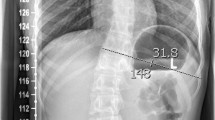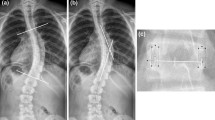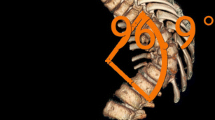Abstract
It is a measurement of Cobb’s angles between adolescent (AIS) and juvenile (JIS) idiopathic scoliosis who had stable curves (variation <5 degrees) in more than three visits. Main objective of this paper is to measure inter- and intra-observer reliability of measurements between AIS and JIS who had stable curves in regular follow-up. Twenty-nine JIS and 44 AIS patients who had stable curves without bracing were identified using PACS system. Two observers independently measured Cobb’s angle twice on first, during follow-up and final radiogram using computer-based digital radiogram. Both observers were given pre-decided level of upper and lower end plates. Inter- and intra-observer reliability of the measurement was calculated using Pearson correlation-coefficient test between JIS and AIS group. There was no significant difference in Cobb’s angle in all measurements by both observers either in JIS (p = 0.756, range 0.706–0.815; ANOVA) or AIS (p = 0.871, range 0.795–0.929; ANOVA) group which suggested that there is no significant difference in Cobb’s angle in repeated measurements. Intra-observer reliability for JIS (r = 0.600, range 0.521–0.751; Pearson test) was less than AIS (r = 0.969, range 0.943–0.984; Pearson test); and similarly, inter-observer reliability for JIS (r = 0.547, Pearson test) was also less than AIS (r = 0.961, Pearson test) which indicates that Cobb’s angle measurement is less reliable in patients who have juvenile idiopathic scoliosis. Using the identical condition for measurements in both the groups, we could find only one reason for less reliability in JIS group and that is poor demarcation of the vertebral end-plates in this group. This poor inter- and intra-observer reliability in JIS due to ill-defined endplates can be reduced by measuring all previous curves along with latest curves at the same time during the follow-up of patients with JIS to decide about the progression of curves and treatment options.



Similar content being viewed by others
References
Bansal GJ (2006) Digital radiography. A comparison with modern conventional imaging. Postgrad Med J 82:425–428. doi:10.1136/pgmj.2005.038448
Brooks HL, Azen SP, Gerberg E, Brooks R, Chan L (1975) Scoliosis: a prospective epidemiological study. J Bone Joint Surg Am 57:968–972
Brown JC, Axelgaard J, Howson DC (1984) Multicenter trial of a noninvasive stimulation method for idiopathic scoliosis: a summary of early treatment results. Spine 9:382–387. doi:10.1097/00007632-198405000-00010
Carman DL, Browne RH, Birch JG (1990) Measurement of scoliosis and kyphosis radiographs: intraobserver and interobserver variation. J Bone Joint Surg Am 72:328–333
Cheung J, Wever DJ, Veldhuizen AG et al (2002) The reliability of quantitative analysis on digital images of the scoliotic spine. Eur Spine J 11:535–542. doi:10.1007/s00586-001-0381-7
Chockalingam N, Dangerfield PH, Giakas G, Cochrane T, Dorgan JC (2002) Computer-assisted Cobb measurement of scoliosis. Eur Spine J 11:353–357. doi:10.1007/s00586-002-0386-x
Cobb JR (1948) Outline for the study of scoliosis. In: Instructional course lectures, vol. 5. American Academy of Orthopedic Surgeons, Ann Arbor, pp 61–75
Dang NR, Moreau MJ, Hill DL, Mahood JK, Raso J (2005) Inter-observer reproducibility and intra-observer reliability of the radiographic parameters in the spinal deformity study group’s AIS radiographic measurement manual. Spine 30(9):1064–1069. doi:10.1097/01.brs.0000160840.51621.6b
Dawson EG, Smith RK, McNiece GM (1978) Radiographic evaluation of scoliosis. A reassessment and introduction of the scoliosis chariot. Clin Orthop Relat Res 131:151–155
Facanha-Filho FA, Winter RB, Lonstein JE et al (2001) Measurement accuracy in congenital scoliosis. J Bone Joint Surg Am 83:42–45
Goldberg MS, Poitras B, Mayo NE et al (1988) Observer variation in assessing spinal curvature and skeletal development in adolescent idiopathic scoliosis. Spine 13:1371–1377. doi:10.1097/00007632-198812000-00008
James JIP (1976) Scoliosis, 2nd ed edn. Churchill Livingstone, Edinburg, pp 10–11
Kuklo TR, Potter BK, O’Brien MF et al (2005) Reliability analysis for digital adolescent idiopathic scoliosis measurement. J Spinal Disord Tech 18:152–159. doi:10.1097/01.bsd.0000148094.75219.b0
Kuklo TR, Potter BK, Polly DW Jr et al (2005) Reliability analysis for manual adolescent idiopathic scoliosis measurements. Spine 30:444–454. doi:10.1097/01.brs.0000153702.99342.9c
Kuklo TR, Potter BK, Schroeder TM, O’Brien MF (2006) Comparison of manual and digital measurements in adolescent idiopathic scoliosis. Spine 11(31):1240–1246. doi:10.1097/01.brs.0000217774.13433.a7
Loder RT, Urquhart A, Steen H et al (1995) Variability in Cobb’s angle measurement in children with congenital scoliosis. J Bone Joint Surg Br 77:768–770
Loder RT, Spiegel D, Gutknecht S, Kleist K, Ly T, Mehbod A (2004) The assessment of intraobserver and interobserver error in the measurement of noncongenital scoliosis in children ≤10 years of age. Spine 22(29):2548–2553. doi:10.1097/01.brs.0000144828.72721.d8
Lonstein JE, Carlson JM (1984) The prediction of curve progression in untreated idiopathic scoliosis during growth. J Bone Joint Surg Am 66:1061–1071
McCollough NCIII (1986) Nonoperative treatment of idiopathic scoliosis using surface electrical stimulation. Spine 11:802–804. doi:10.1097/00007632-198610000-00010
Mok JM, Berven SH, Diab M, Hackbarth M, Hu SS, Devieren V (2008) Comparison of observer variation in conventional and three digital radiographic methods used in the evaluation of patients with adolescent idiopathic scoliosis. Spine 6(33):681–686
Morrissy RT, Goldsmith GS, Hall EC et al (1990) Measurement of the Cobb angle on radiographs of patients who have scoliosis: evaluation of intrinsic error. J Bone Joint Surg Am 72:320–327
Munro BH (1997) Correlation. In: Munro BH (ed) Statistical methods for health care research, 3rd edn. Lippincott-Raven, Philadelphia, pp 224–245
Oda M, Rauh S, Gregory PB et al (1982) The significance of roentgenographic measurement in scoliosis. J Pediatr Orthop 2:378–382
Rogala EJ, Drummond DS, Gurr J (1978) Scoliosis: incidence and natural history. A prospective epidemiological study. J Bone Joint Surg Am 60:173–176
Sapkas G, Papagelopoulos PJ, Kateros K, Koundis GL, Boscainos PJ, Koukou UI, Katonis P (2003) Prediction of Cobb angle in idiopathic adolescent scoliosis. Clin Orthop Relat Res 411:32–39. doi:10.1097/01.blo.0000068360.47147.30
Sevastikoglou JA, Bergquist E (1969) Evaluation of the reliability if radiological methods for registration of scoliosis. Acta Orthop Scand 40:608–613
Shea KG, Stevens PM, Nelson M et al (1998) A comparison of manual versus computer-assisted radiographic measurement intraobserver measurement variability for Cobb angles. Spine 23:551–555. doi:10.1097/00007632-199803010-00007
Stokes IAF, Aronsson DD (2006) Computer-assisted algorithms improve reliability of King classification and Cobb angle measurement of scoliosis. Spine 6(31):665–670. doi:10.1097/01.brs.0000203708.49972.ab
Wills BPD, Auerbach JD, Zhu X, Caird MS, Horn BD, Flynn JM, Drummond DS, Dormans JP, Ecker ML (2007) Comparison of Cobb angle measurement of scoliosis radiographs with preselected end vertebrae. Traditional versus digital acquisition. Spine 1(32):98–105. doi:10.1097/01.brs.0000251086.84420.d1
Zetterberg C, Hansson T, Lidstrom J, Irstram L, Andersson G (1983) Daytine postural changes of the scoliosis spine. Orthop Trans 7:7–8
Conflict of interest statement
Each author certifies that he has no commercial associations (e.g., consultancies, stock ownership, equity interests, patent/licensing arrangements, etc.) that might pose a conflict of interest in connection with the submitted article.
Author information
Authors and Affiliations
Corresponding author
Rights and permissions
About this article
Cite this article
Modi, H.N., Chen, T., Suh, S.W. et al. Observer reliability between juvenile and adolescent idiopathic scoliosis in measurement of stable Cobb’s angle. Eur Spine J 18, 52–58 (2009). https://doi.org/10.1007/s00586-008-0834-3
Received:
Revised:
Accepted:
Published:
Issue Date:
DOI: https://doi.org/10.1007/s00586-008-0834-3




